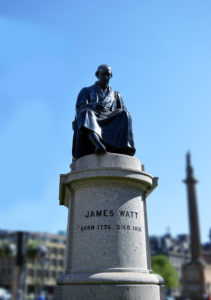The History of the Term “Horsepower”

When talking about motors and drives one term that important to understand is horsepower. When applying this concept to motors, horsepower represents the amount of work that can be applied over a given torque and speed. Choosing what horsepower is necessary to make an application work is a key skill that is one of the first concepts engineers learn.
But where does the term horsepower come from?
 It all started with a man by the name of James Watt in the late 1700s – who coincidental to this article – is also the namesake of another unit of power, the Watt. James Watt was a Scottish inventor, engineer and teacher who was responsible for great advancements in industrial technology during the industrial revolution most notably the steam engine.
It all started with a man by the name of James Watt in the late 1700s – who coincidental to this article – is also the namesake of another unit of power, the Watt. James Watt was a Scottish inventor, engineer and teacher who was responsible for great advancements in industrial technology during the industrial revolution most notably the steam engine.
The story goes that while Watt’s advancements in steam technology were a great success and made him very wealthy, he would often run into trouble marketing this technology to folks who were entirely reliant on horses to do most of the hard-mechanical work that his engines were set to replace. While selling his engines he was asked a question. How many horses could one engine replace? This gave Watt the idea to create a new piece of clever marketing, a new unit of power to represent this concept to the farmers and miners he was selling to: “Horsepower”.
While working with coal miners he set up an experiment. He would have horses walk around a wheel connected to a pulley system that would lift a load of coal. Through his calculations he determined that a horse could on average lift around 33,000 foot pounds per minute. A foot-pound is the amount of force necessary to lift 1 pound over 1 foot of distance. Therefor he determined that 33,000 foot pounds per minute would equal 1 horsepower. We still use this calculation to this day.